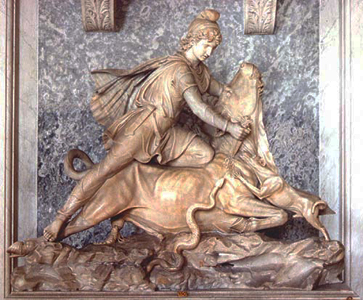Masson André, Corrida au soleil
One year ago, in a greatest sacred city, I have been attacked by the big huge bull. Despite my dark blue hip, this incident has not frightened me for some reason but has forced to think about significance of this event. Certainly, all that occurs in a holy site is fairly and for Good anyhow but the bull himself - what is the force which it represents? I saw its wild red eyes but the first bull which we remember in hinduism is sacred Nandi, Shiva's primary vehicle, the righteousness and Dharma himself.
Om Mahaakaalyam Mahaaveeryam
Shiva Vahanam Outatmama
Ganaanamtwa Pratham Vande
Nandishwaram Mahabalam
Shiva Vahanam Outatmama
Ganaanamtwa Pratham Vande
Nandishwaram Mahabalam
At the same time we see a demon-bull won by the beautiful Goddess Mahisasura Mardini. It's a bull too. According to biology, there are a little separate species in terms of their nature and characteristics.
Nandi is vRSa (bull) in sanskrit, and Mahishasura is mahiSa (buffalo). Besides Nandi is a calf, and Mahishasura is an adult bull, it is important that this the second was born out of union of asura with a buffalo. That reminds me an other "part bull", the Minotaur.
In Greek mythology, he was the product of union of king Minos’s wife with the bull. Interesting that Minos prayed that this bull might appear, promising to sacrifice it. Poseidon, God of the sea, did send him up a fine bull, but Minos sent him to the herds and sacrificed another. Thus the promise has been broken and Minos’s punishment for his impiety is a half-human, half-animal son. The Minotaur is, in Euripides words, "A mingled form where two strange shapes combined, and different natures, bull and man, were joined", "a mingled form and hybrid birth of monstrous shape". On another level, these creatures are identified in part with animality, symbolising the savage aspect of human nature itself, or man dominated by instincts. When hero like Theseus confronts the mythic creature, his or her victory represents our victory over the animal in ourselves.
Similar symbol is present at many cultures. Ushi-Oni is a bull headed creature from Japanese mythology while the Mesopotamians had Shedu, and most will have heard of the Centaur, a variation of the half-man half-bull with a horse's body and man's head though it is occasionally portrayed with a bull's body. The Centaur, the fusion of a man and beast, is historically a Roman symbol of violent tendencies, and of the ugly side of humanity. Here we see Minerva (or Athena for Greeks), the virgin goddess of wisdom, winning a Centaur.
It is possible to find much more complex symbolism of bull's image in religion. For example, one of the central motifs of Mithraism is the sacrifice by Mithra of a sacred bull. In every temple of this mystic religion the centrepiece was a representation of this story.After its sacrifice, from the body of the dying bull spring plants, animals, and all the beneficial things of the earth. The bull, resigning itself to death, is transported to the heavenly spheres, redeemed by its sacrifice. There are many explanations: it has been variously decided that the bull slain by Mithra is the symbol of the earth, the symbol of the moon, the symbol of the sun, the symbol of lust, the symbol of evil, the symbol of the cloud, the bull of the Zodiac, and the cosmogonic bull of the Magian system. Sometimes it is considered that it is connected with the symbolism of the Veda, where Agni is the bull; "Bull, who beholdest men, through many mornings, among the dark ones shine forth red, O Agni."( RV Hymn 3.1.3)
Thus, we can see a sacred bull with two distinct aspects: a beneficent, lucent, vital and a dangerous, sinister, morbid side. At the same time, however, the bull also embodies aggression, courage, nobility, and the like - masculine virtues valued in traditional society. It is the dual symbolism of the bull as an ambiguous force, internally divided against itself.
From this point of view I consider the Spanish bullfight as the rest of the ancient form of sacrifice. I don't claim that the modern bullfight might be considered sacred, and it does not override the ethical imperative to protect animals from cruelty. It is not the ritual but the cruel sport now. But in that juxtaposition of the raw virility of the bull and the graceful motions of the matador, which also risks life, I see an ancient echo of collision of two forces.
Krishna killing the Arishta demon
Also Kill Bull 2 , 3 and 4







No comments:
Post a Comment